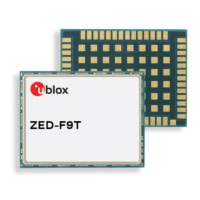ZED-F9T-Integration Manual
3.1.7.1 Platform settings
u-blox receivers support different dynamic platform models (see table below) to adjust the
navigation engine to the expected application environment. These platform settings can be
changed dynamically without performing a power cycle or reset. The settings improve the receiver's
interpretation of the measurements and thus provide a more accurate position output. Setting the
receiver to an unsuitable platform model for the given application environment is likely to result in
a loss of receiver performance and position accuracy.
The dynamic platform model can be configured through the CFG-NAVSPG-DYNMODEL
configuration item. The supported dynamic platform models and their details can be seen in Table
11 and Table 12 below.
Platform Description
Portable Applications with low acceleration, e.g. portable devices. Suitable for most situations.
Stationary Used in timing applications (antenna must be stationary) or other stationary applications.
Velocity restricted to 0 m/s. Zero dynamics assumed.
Pedestrian Applications with low acceleration and speed, e.g. how a pedestrian would move. Low
acceleration assumed.
Automotive Used for applications with equivalent dynamics to those of a passenger car. Low vertical
acceleration assumed.
At sea Recommended for applications at sea, with zero vertical velocity. Zero vertical velocity assumed.
Sea level assumed.
Airborne <1g Used for applications with a higher dynamic range and greater vertical acceleration than a
passenger car. No 2D position fixes supported.
Airborne <2g Recommended for typical airborne environments. No 2D position fixes supported.
Airborne <4g Only recommended for extremely dynamic environments. No 2D position fixes supported.
Wrist Only recommended for wrist worn applications. Receiver will filter out arm motion.
Table 11: Dynamic platform models
Platform Max altitude [m] Max horizontal
velocity [m/s]
Max vertical velocity
[m/s]
Sanity check type Max
position
deviation
Portable 12000 310 50 Altitude and velocity Medium
Stationary 9000 10 6 Altitude and velocity Small
Pedestrian 9000 30 20 Altitude and velocity Small
Automotive 6000 100 15 Altitude and velocity Medium
At sea 500 25 5 Altitude and velocity Medium
Airborne <1g 50000 100 100 Altitude Large
Airborne <2g 50000 250 100 Altitude Large
Airborne <4g 50000 500 100 Altitude Large
Wrist 9000 30 20 Altitude and velocity Medium
Table 12: Dynamic platform model details
Dynamic platforms designed for high acceleration systems (e.g. airborne <2g) can result in a higher
standard deviation in the reported position.
If a sanity check against a limit of the dynamic platform model fails, then the position solution
is invalidated. Table 12 above shows the types of sanity checks which are applied for a particular
dynamic platform model.
3.1.7.2 Navigation input filters
The navigation input filters in CFG-NAVSPG-* configuration group provide the input data of the
navigation engine.
UBX-19005590 - R01
3 Receiver functionality Page 16 of 80
Advance Information

